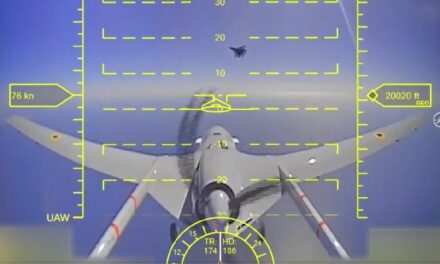We support our Publishers and Content Creators. You can view this story on their website by CLICKING HERE.
Key Points: The French Rubis-class submarines, though aging, remain a formidable component of the French Navy, with significant carrier escort duties and proven operational prowess.
-Despite being scheduled for retirement by the 2030s, these nuclear-powered fast attack subs have shown exceptional capabilities, including a simulated “sinking” of the USS Theodore Roosevelt during a 2015 exercise.
-Compact, fast, and equipped with heavy torpedoes and Exocet anti-ship missiles, the Rubis-class demonstrates the skill and adaptability of French naval forces.
-Their legacy and operational value warrant consideration for extended service until fully replaced by the newer Suffren-class submarines.
Let’s Give a Rousing Review to the French Navy: When I say the words “French military” you may not be impressed. World War Two jokes aside, you probably associate France’s armed forces more with counter-insurgency, counter-terror, and special operations. The French struggled with counter-insurgency in Vietnam and Algeria but made up for it in their latest “COIN” operation in Mali that lasted from 2013 to 2022. Despite some analysts thinking that the Mali experience was a failure, French light infantry and special operations forces have endurance and toughness that can take on long-term engagements, do their job, and head home without a high level of casualties.
French Submarines Are Noteworthy: Enter the Rubis-Class
But what if I told you that it is the French navy that you must keep an eye on?
The navy is not a huge calling card that is associated with France. And to get even more specific, there is a French class of submarines that are growing long in the tooth but are still highly effective. Let’s examine the Rubis-class of nuclear-powered fast attack subs and what makes them so special.
Significant Carrier Escort Duties
The Rubis-class make up the backbone of the French submarine fleet. They often sail as part of a strike group with France’s Charles De Gaulle aircraft carrier. More carrier operations are necessary now with the advent of the Russo-Ukraine war.
(Jan. 25, 2020) The aircraft carrier USS Theodore Roosevelt (CVN 71) transits the Pacific Ocean Jan. 25, 2020. The Theodore Roosevelt Carrier Strike Group is on a scheduled deployment to the Indo-Pacific. (U.S. Navy photo by Mass Communication Specialist Seaman Kaylianna Genier)
They Will Be Retired in the 2030s
The Rubis-class is stationed at the Mediterranean port of Toulon. Rubis-class subs were built in the 1980s and will eventually be replaced by the new Suffren-class that will come completely online by 2030. The first Suffren-class set forth in 2022. The second Suffren-class, the Duguay-Trouin, officially hit the water this year.
Rubis-Class Submarine Specs
There are only three Rubis-class subs left in service. The Rubis-class is 241 feet long and 25 feet wide. The subs displace only 2,600 tons underwater. They feature the K48 pressurized water nuclear reactor with one shaft and one propellor. Their top speed is 25 knots submerged and that’s a pretty impressive speed.
The Rubis-class features four 21-inch torpedo tubes that send F17 Mod.2 heavy torpedoes to paydirt. The boat can also launch Exocet SM39 anti-ship missiles.
The Story About the Rubis-Class ‘Fight’ Against the U.S. Navy
You normally wouldn’t associate the Rubis-class as being very noteworthy, France likes to stay quiet about its nuclear-powered boats, but they are known for one distinction that gained publicity. A Rubis-class once “sunk” a U.S. aircraft carrier in 2015.
What Happened During This Simulated Battle?
The first day of the exercise in question happened without a hitch. The 30-year-old Rubis-class sub named Saphir was patrolling with the USS Theodore Roosevelt a $4.5 billion aircraft carrier.
The Roosevelt was conducting flight-deck operations and Saphir was part of the strike group, and its mission was to make sure no enemy submarines advanced on the carrier and launched torpedoes or anti-ship missiles. Saphir did its job and there were no problems.
Day Two of the drill was different. Saphir switched over to the “enemy” team to challenge the Roosevelt. This is when the crew of the Saphir showed their mettle. Faced with several ships and aircraft that were engaging in anti-submarine warfare, Saphir snuck around the Roosevelt strike group without being discovered. It advanced close enough to the carrier to simulate a launch of torpedoes and Exocet missiles. The Saphir was credited with a “kill” after it “sunk” the American carrier. Not bad for a sub that was commissioned in 1984.
Skill of the Crew Turned the Tide
You have to give credit to the crew of the Saphir, but it is not known for being the stealthiest boat. But it is fast and maneuverable, and the Americans were likely alarmed that a sub as old as the Saphir was able to conduct such a successful drill against the Theodore Roosevelt.
The French Should Re-evaluate Plans to Retire the Rubis-class
U.S. Naval war planners may be still scratching their heads almost 10 years after the Roosevelt’s “sinking” by the allied sub. Losing an aircraft carrier to such an unheralded boat is problematic. Hopefully, the Americans studied what happened and have adjusted their order of battle. Russia and China are probably pointing to this exercise and concluding that American carriers are vulnerable to even older nuclear-powered subs. Meanwhile, France may want to keep the Saphir in service rather than retiring it. The Rubis-class sub has what all naval vessels strive for: skill and luck.
About the Author: Dr. Brent M. Eastwood
Brent M. Eastwood, PhD, is the author of Don’t Turn Your Back On the World: a Conservative Foreign Policy and Humans, Machines, and Data: Future Trends in Warfare plus two other books. Brent was the founder and CEO of a tech firm that predicted world events using artificial intelligence. He served as a legislative fellow for U.S. Senator Tim Scott and advised the senator on defense and foreign policy issues. He has taught at American University, George Washington University, and George Mason University. Brent is a former U.S. Army Infantry officer. He can be followed on X @BMEastwood.

 Conservative
Conservative  Search
Search Trending
Trending Current News
Current News 





